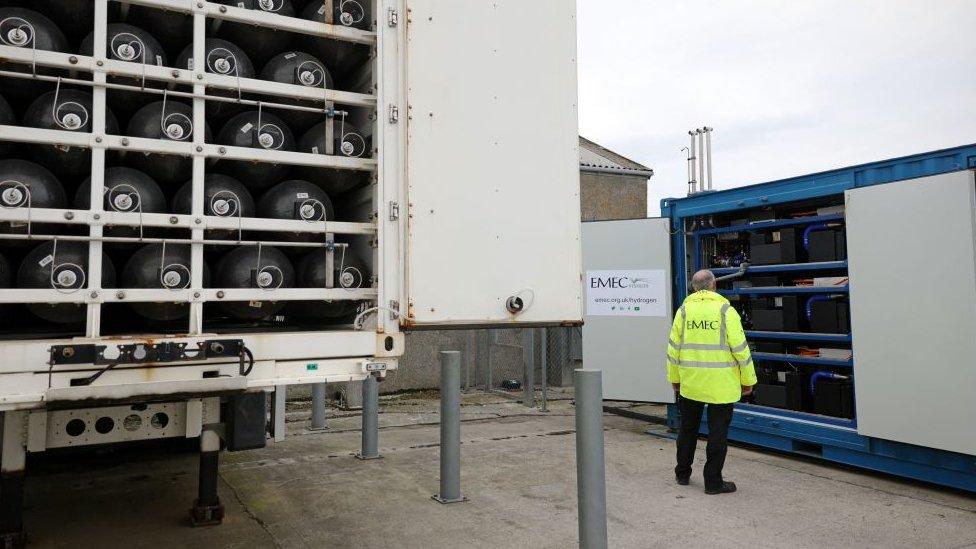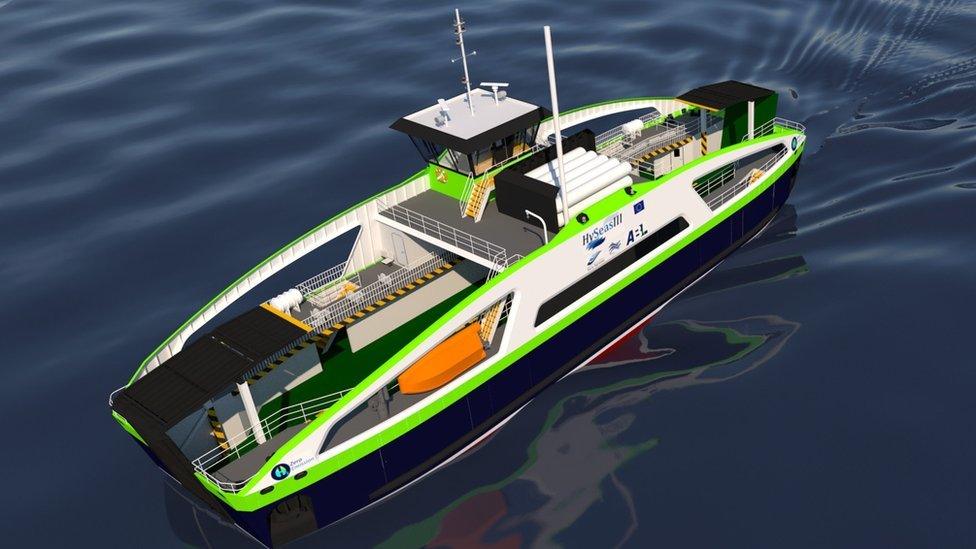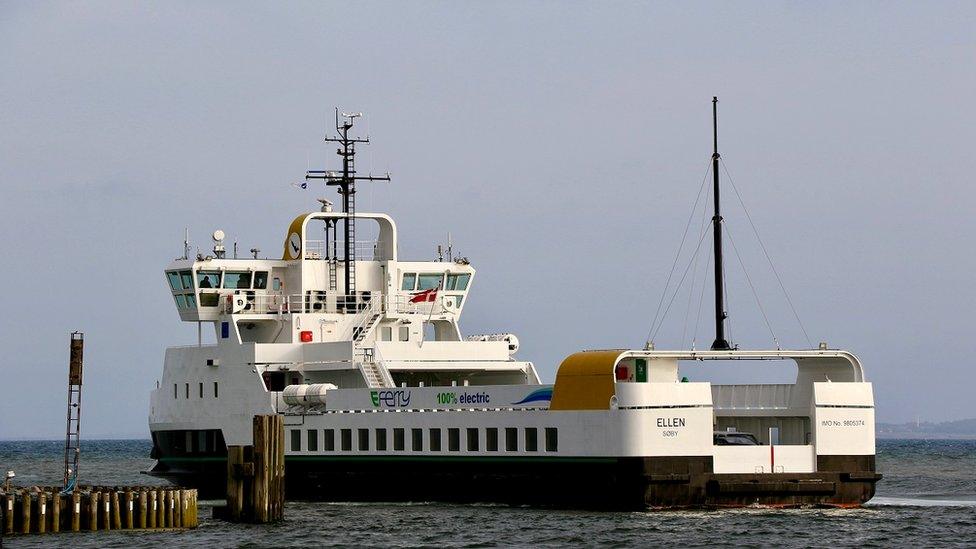Will Scotland build a hydrogen-powered ship?
- Published
- comments

A project that aims to put Scotland at the forefront of zero-emission hydrogen technology has delivered a blueprint for a small ferry for Orkney. But will it happen?
"Ferries" has become something of a dirty word in Scotland in recent years. An increasingly unreliable fleet coupled with massive cost overruns and delays in building new vessels are regular news headlines.
At the same time, a disparate group of organisations, private companies and academics - both in Scotland and Europe - have been quietly working together on a far more optimistic vision for the future.
For a decade, they have been testing the feasibility of transporting people and vehicles across lochs and seas using hydrogen, a fuel where the only by-product is water so pure you can drink it.
The Shapinsay ferry
HySeas III, the project's latest incarnation, has a very specific goal - to build a small, double-ended vessel to transport passengers and cars on a 25-minute route between Kirkwall and Shapinsay in Orkney.
Orkney was chosen for a reason. The island community, just north of the Scottish mainland, is a world leader in pioneering a hydrogen economy.
The islands have far more wind and tidal energy than they need for domestic electricity consumption but the National Grid cannot always handle the surplus.
Rather than shutting the wind turbines down for periods, they are instead being used for electrolysis, splitting water molecules into oxygen and hydrogen.

Orkney is using electrolysers to produce "green hydrogen".
That "green hydrogen" can then be used to generate electricity when required using something called a hydrogen fuel cell.
Already fuel cells are powering a small fleet of council vans, heating buildings and providing electricity to ships moored in Kirkwall harbour. For a community that relies so much on boats to get around the obvious next step is ferries.
Sounds straightforward? It's not quite that simple.
Challenges and choices
Firstly there have been technological challenges - and choices to make.
Hydrogen can be mixed with other fuels and burned directly in an internal combustion engine, emitting far smaller quantities of CO2. But that method produces other harmful pollutants - nitrogen and sulphur oxides, known as NOx and SOx.
Instead, the HySeas project chose the far greener fuel cell approach - using hydrogen to produce electricity to drive electric motors.

The technological hurdles have largely been overcome. A marine-certified hydrogen fuel cell, about the size of a wardrobe, can deliver 200 kilowatts of electricity. Output can be scaled up like building blocks - the Orkney boat would require three of them.
As well as the fuel cells, the ferry would also need 7.5 tonnes of batteries to act as a buffer, smoothing out the power supply to the motors, providing extra power when needed - but also ensuring the ferry could make it to port if the fuel cells broke down.
A bigger headache has been regulations - or rather the lack of them. The team have often struggled to achieve regulatory sign-off when the rule book hasn't kept pace with technology.
Despite those challenges, a training programme for crews has been approved. Last week a key milestone was reached when maritime regulators DNV gave the prototype design the green light.
The Hindenburg fear
Hydrogen already has its place in the history of transport.
The first modern airship, the Zepellin LZ1, took to the skies in 1900, three years before the Wright brothers and their winged aircraft.
For decades hydrogen-filled airships offered a cost-effective means of air travel - but that came crashing down on the 6 May 1937 when the Hindenburg exploded in a massive fireball while landing in New Jersey.

The Hindenburg disaster in 1937 shook public confidence in airship travel
The 35 deaths, coupled with the even deadlier crash of the R101 airship seven years earlier, destroyed confidence in airship travel, forcing a switch to the safer but more expensive gas helium.
Hydrogen is extremely flammable - but then so too are many other fuels such as petrol. Already hydrogen is being used to fuel buses in Aberdeen.
Project leader Dr Martin Smith, of St Andrews University, points out that until the 1970s it was coal gas - which is 50% hydrogen - rather than natural gas which was piped into millions of homes.
"Your granny, your great-granny and your great-great-granny will have been using hydrogen as a fuel," he explains.
"It's not the scary new fuel that it's sometimes presented as - it's been around a very long time."

The hydrogen would be stored in carbon fibre tanks on the wheelhouse deck
In order to satisfy regulators, the designers plan to store the hydrogen in pressurised carbon fibre tanks located on the ferry's wheelhouse deck.
The risks from a leak or, in the worst case scenario, an explosion have been carefully modelled and the degree of pressurisation chosen to limit the potential for harm.
In one respect, using the lightest element on Earth as a fuel has a safety advantage - if there's a leak it just floats away.
Lost momentum
A few years ago it looked like the planned Orkney boat might be the world's first hydrogen-powered ferry but, like the race to the South Pole in the early 20th Century, that accolade will almost certainly be won by the Norwegians.
HySeas III suffered a huge setback when the lead design partner, the Ferguson Marine shipyard in Port Glasgow, went into administration and was nationalised in 2019, affecting project funding and creating a mountain of paperwork.
Scottish government ferries agency CMAL took over the design role and began the process from scratch.
In the meantime the Norwegian ferry firm Norled has taken delivery of an 82m (269ft)-long vessel called Hydra which looks set to become the world's first hydrogen-powered ferry later this year.
Hydra's fuel cells are installed but it is currently running on batteries due to a shortage of locally-produced hydrogen. They're currently finalising the logistics of importing it from Germany.
While it may not be the first hydrogen ferry in the world, the Orkney ferry would still be unique as a model of sustainability - locally-produced hydrogen powering a vessel without the emissions that result from transporting fuel long distances.
Other future fuels
Hydrogen is not the only candidate when it comes to charting a course to a zero emission future for ships.
Ferries that are wholly-powered by batteries are increasingly commonplace, especially in Scandinavia.
In Scotland, seven replacement small vessels currently being planned for west coast ferry operator CalMac are expected to be battery-powered.
But at the moment all-electric boats are seen as best-suited for shorter journeys or routes where recharging time isn't a major issue.
For the longest journeys, the maritime industry is also looking at ammonia or methanol as a future fuel because they are easier to store.
Charting a course to a greener future may involve several technologies rather than "one size fits all".

The battery-powered ferry Ellen operates on a 25-mile route in southern Denmark
Cost is also an issue. Saving the planet doesn't come cheap.
The price of green hydrogen, produced by electrolysis, is linked to the cost of purchasing electricity - which is, in turn, linked with the wholesale price of gas under the current system.
Sustainable hydrogen is almost double the cost of diesel at the moment, though as more wind energy and electrolysis comes on stream some predict it will eventually become cheaper than fossil fuels.
Another challenge is creating enough of it. Scotland's west coast lacks Orkney's hydrogen infrastructure, and putting it in place would require millions of pounds of investment.
Dr Smith, however, argues there would also be wider economic benefits in job creation. Using wind power to create hydrogen, he says, is a cost-effective way of storing green energy.
"You can't build a battery the size of Ben Nevis on Skye. It's far easier to store renewable energy as a compressed gas."
The prototype ferry being proposed for Orkney, along with the refuelling infrastructure, would cost about £25m - more than twice the bill for a similar-sized conventional vessel.
Will it be built? That largely depends on whether politicians at Holyrood or in Orkney think it's a price worth paying.
Prof Smith is not an unbiased voice, but he has strong views on what should happen next.
"We've ticked all the boxes, we've spent a long time doing this - and we've seen people in other parts of the world catch up," he says.
"If we are to be a world leader in hydrogen technology, we need leadership and we need to do this."
Such a boat would do little to alleviate the pressures on Scotland's hard-pressed ferry network in the short-term, but the technology at least offers a glimpse of what might be possible in the years ahead.